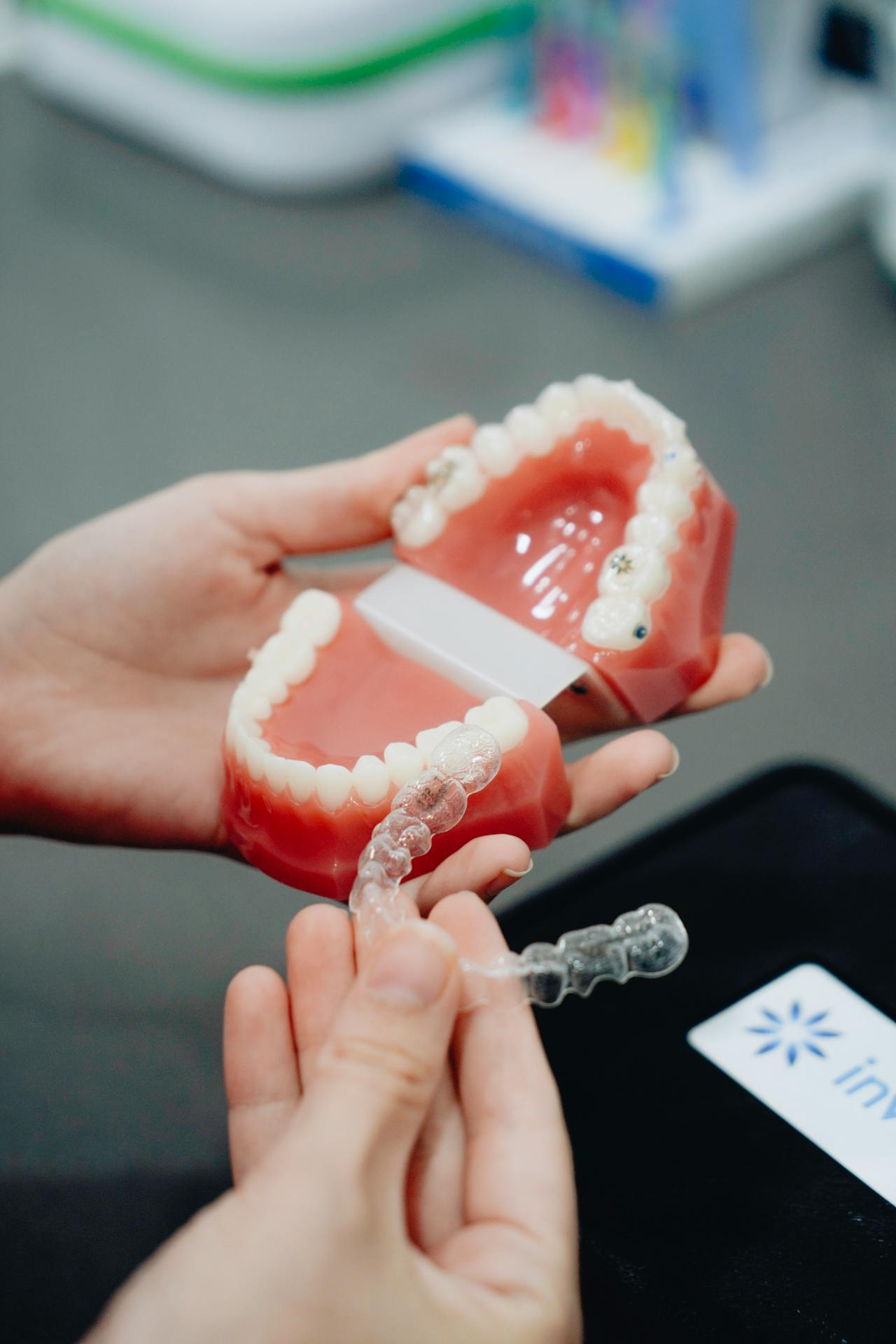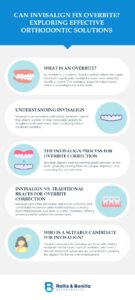Can Invisalign Fix Overbite? Exploring Effective Orthodontic Solutions

Traditional braces have historically been the go-to option for correcting overbites, using brackets and wires to move teeth into the right position gradually. However, with the advancements in orthodontic treatments, many individuals are now curious about the effectiveness of Invisalign in addressing this particular dental issue. This blog post aims to explore the capabilities of Invisalign in treating overbites, compare it with other orthodontic treatments, and guide you through what to expect if you consider this path. Let’s dive into the world of modern orthodontics and discover how Invisalign might be the key to unlocking your best smile.
What Is an Overbite?
An overbite is a common dental condition where the upper front teeth significantly overlap the lower ones when the mouth is closed. This overlap is a type of malocclusion, which is a misalignment of the teeth. While a slight overlap is normal and even necessary for a proper bite, severe overbites can lead to a range of dental health issues, such as tooth decay, gum disease, constant jaw pain, and temporomandibular joint (TMJ) disorders. It can also make chewing and speaking quite challenging.
There are two main types of overbites:
- Dental Overbite – A dental overbite mainly occurs due to the external interruption of dental development, such as crowding, losing back teeth, or other bad oral habits (prolonged thumb-sucking in childhood).
- Skeletal Overbite – A skeletal overbite occurs due to irregular jawbone development that causes the jaws and teeth to grow. This can be caused by an overdeveloped upper jaw or underdeveloped lower jaw, often influenced by genetic components.
These two types of overbites can occur individually or in combination. Identifying an overbite early and understanding its nature—whether dental or skeletal—can lead to more effective and timely treatment options. The goal is not just to enhance the aesthetics of your smile but also to improve oral health and functionality, ensuring you can enjoy a wide variety of foods and maintain good dental hygiene more easily.

Understanding Invisalign
Invisalign has revolutionized the world of orthodontics, offering a nearly invisible way to straighten teeth and correct bites, including mild to moderate overbites. Unlike traditional braces, which use metal brackets and wires, Invisalign uses a series of clear, plastic aligners that are custom-made to fit snugly over your teeth. These aligners are not only discreet but also removable, allowing for easier eating, brushing, and flossing—a significant advantage for maintaining oral hygiene during treatment.
The process begins with a consultation with an orthodontist, who takes detailed images and impressions of your mouth. These are then used to create a digital treatment plan that maps out the step-by-step transformation of your smile. Each plastic aligner is worn for a week before moving on to the next in the series, gradually shifting your teeth into the desired position. The beauty of Invisalign lies in its precision and customization; each aligner is part of a carefully planned journey toward a more aligned bite and a confident smile.
One of the most appealing aspects of Invisalign is its flexibility. The invisible aligners can be removed for special occasions, though they need to be worn for 20-22 hours a day to achieve the best results. This balance between effectiveness and lifestyle flexibility makes Invisalign a preferred choice for many adults and teens seeking orthodontic treatment without the aesthetic and practical limitations of traditional metal braces.
Invisalign is suitable for correcting a wide range of orthodontic issues, including overbites, underbites, crossbites, gap teeth, and crowded teeth. While it offers an attractive alternative to braces, it’s important to consult with an orthodontist to determine if Invisalign is the best solution for your specific needs.
The Invisalign Process for Overbite Correction
Invisalign aligners work by exerting gentle pressure on the teeth, gradually moving them into proper alignment, and correcting the bite over time. The average treatment time for Invisalign is around 12 to 24 months, depending on individual needs and progress.
Here’s how Invisalign works for correcting an overbite:
- Initial Consultation – Your journey starts with visiting an orthodontist specializing in Invisalign treatment. During this appointment, the orthodontist will assess your condition, including the severity of your overbite and overall dental health, to determine if Invisalign is the right treatment option for you.
- Creating a Custom Treatment Plan – If Invisalign is deemed suitable for your overbite, your orthodontist will create a personalized treatment plan tailored to your needs. Using advanced iTero digital scanning technology, your orthodontist captures detailed images of your teeth and jaw. The images are then used to design a custom treatment plan that outlines how each plastic aligner will shift your teeth into the perfect position, gradually correcting your overbite.
- Receiving Your Custom Aligners – Once your treatment plan is finalized, a series of custom aligners will be made for you. You’ll wear each set of aligners for a week before moving on to the next set in the series. Each aligner is slightly different, moving your teeth gradually over time.
- Regular Check-Ups – Throughout your treatment process, you will have regular check-ups with your orthodontist to track your progress (usually every six to 10 weeks). These appointments are much less frequent than what you might expect with traditional braces.
- Retainer Use – After your teeth have reached their ideal positions, you might need to wear a retainer to keep them in place. Your orthodontist will guide you on how long to wear your retainer to ensure your beautiful, new smile lasts a lifetime.
If you’re considering Invisalign for your overbite correction process, remember a consultation with a professional is the best way to explore how this innovative treatment can work for you.
Invisalign vs. Traditional Braces for Overbite Correction
When it comes to correcting an overbite, you have options, and understanding the differences between Invisalign and traditional braces is key to making the best choice for your smile. Both methods are effective, but they offer different benefits and experiences.
- Visibility – One of the most appealing aspects of Invisalign is its near invisibility. The clear aligners are hard to notice, making them a popular choice for adults and teens who are self-conscious about wearing braces. Traditional braces, with their metal brackets and wires, are more visible.
- Comfort – Invisalign aligners are made from smooth plastic and are custom-fitted, reducing the chances of irritation to the inside of your mouth. Traditional braces, on the other hand, can sometimes cause discomfort due to the metal wires and brackets rubbing against your cheeks and lips.
- Convenience – A significant advantage of Invisalign is the ability to remove the aligners when eating, drinking, brushing, and flossing. This flexibility allows you to maintain your dietary habits and oral hygiene routine more easily than with traditional braces, which require special cleaning techniques and food restrictions.
- Effectiveness – Both Invisalign and traditional braces can effectively correct overbites. However, Invisalign is more suitable for correcting mild to moderate overbites, whereas traditional braces are suitable for mild to severe overbites.
- Treatment Time – The duration of treatment with both Invisalign and traditional braces can vary depending on the complexity of the overbite. In most cases, Invisalign treatments often take less time than traditional braces.
- Adjustments and Visits – Invisalign requires fewer visits to the orthodontist since there are no brackets to adjust or wires to tighten. You’ll still have regular check-ups, but these are generally spread out every six to ten weeks. With traditional braces, appointments are more frequent, usually every six to eight weeks, for adjustments.
Choosing between Invisalign and traditional braces comes down to personal preferences, lifestyle, and the specific needs of your overbite correction. Both options can lead to a beautiful smile and improved dental health.
It’s important to note that for severe skeletal overbites, where the issue is due to jaw alignment rather than just teeth, surgical interventions might be recommended. Orthognathic surgery is a more invasive option that involves repositioning the jaw to correct the skeletal overbite. This surgery is typically reserved for severe cases that cannot be corrected with other orthodontic treatments.
Who Is a Suitable Candidate for Invisalign?
Determining who is a good candidate for Invisalign involves assessing various factors about your dental health, lifestyle, and specific orthodontic needs.
- Individuals with Mild to Moderate Orthodontic Issues – Invisalign is highly effective for correcting mild to moderate overbites, underbites, crossbites, gap teeth, and crowded teeth. If your orthodontic issues are not extremely severe, Invisalign can offer a convenient and efficient solution to achieve the desired alignment and bite correction.
- Adults and Kids Seeking a Discreet Solution – Invisalign is available for children and adults. Invisalign First treatment is a type of Phase One treatment for children between six and ten years old.
- Commitment to Wear – For Invisalign to work, you must be committed to wearing your aligners for the recommended 20 to 22 hours per day. This dedication is crucial for success and requires a level of responsibility. If you’re someone who can stick to this routine, Invisalign might be suitable for you.
- Good Oral Health – A good candidate for Invisalign has healthy teeth and gums. Gum disease, cavities, and other untreated dental problems can affect the success of Invisalign treatment. Before starting, any existing oral health issues should be addressed.
The best way to determine if you are a suitable candidate for Invisalign is to consult with an orthodontist. They can assess your specific situation, including the complexity of your orthodontic needs, and advise whether Invisalign is the best option for you.
Achieving the perfect smile you’ve always dreamed of is within reach. Rallis and Bonilla Orthodontics in Lincoln, NE, is here to guide you every step of the way. With a commitment to personalized care, cutting-edge technology, and a friendly, professional environment, our team is dedicated to providing the best orthodontic solutions, including Invisalign and braces, tailored to meet your individual needs and goals.
Don’t let concerns about your smile hold you back any longer. Take the first step towards a more confident, radiant smile by scheduling a consultation at one of our convenient locations: North Star Office, 84th Street Office, or Yankee Hill Office.